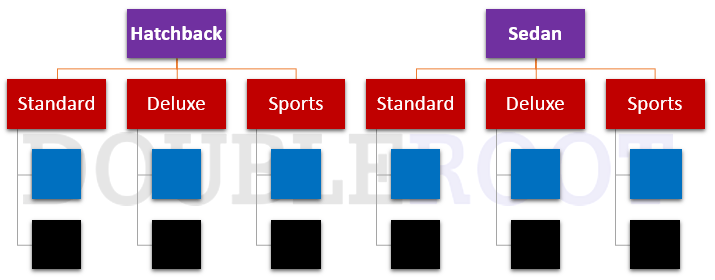This lesson will cover the two basic principles of counting – The Multiplication Principle and The Addition Principle.
All subsequent concepts, (and formulas) in Permutations & Combinations will build upon these two principles, which are pretty simple to grasp.
Fundamental Principle of Counting
To introduce the principles, let’s consider a simple problem:
Suppose a car company sells the following categories of cars…
 |
 |
|
Hatchback |
Sedan |
… each of which comes in 3 different models…
|
|
|
|
|
Standard |
Deluxe |
Sports |
A simple question: How many different types of cars does the company sell?
Before reading further, think about it for a minute and try find out the answer yourself (and of course, don’t worry about getting it wrong)
Let us list all the possible cases.

By counting all the cases, we can see that there are 6 different types of cars in all. (Did you get it right?)
Here’s how we can reach that number by a simple calculation.
Since there are 2 car categories (hatchback & sedan), and each of these comes in 3 different models, the total number of types of cars can be obtained multiplying the number of categories (2) with the number of models available for each category (3), which is 2 x 3 = 6.
(In other words there will be 3 hatchback models + 3 sedan models = 2 x 3 = 6 total types of cars)
Let’s complicate the problem a bit. Suppose each of the above models were available in 2 different colors.

How many different cars do you think are available now? Let’s count again.

This time, there are 12 different types of cars in total.
Since each of the car is available in two colors, and there are 6 different types of cars (as calculated above), we have 6 blue cars + 6 black cars = 6 x 2 = 12 cars.
And this number can be obtained by multiplying together, the number of categories of cars (2), number of models for each category (3) and the number of colors available for each model (2): 2 x 3 x 2 = 12.
And what if there was another color (say red) available for each model? The total number of cars would now be obtained by multiplying 2 (categories), 3 (models per category) and 3 (color per model), which equals 18 (2 x 3 x 3).
(Note that this is 6 more than the number 12 obtained previously, as there would be 6 more red cars)
Makes sense? Try listing these 18 cases to make sure everything’s all right.
I’ll stop for now. In the next part, we’ll move on to the Multiplication Principle, and see some of its applications.
(PS: We’ve already used the Multiplication Principle thrice in this part !)


